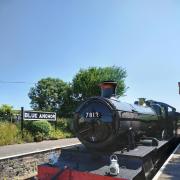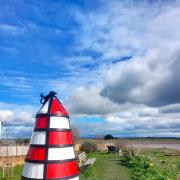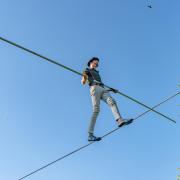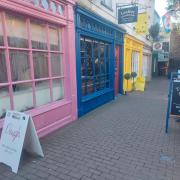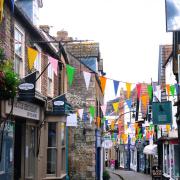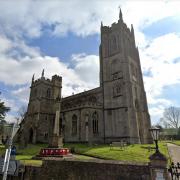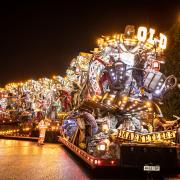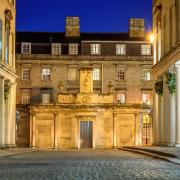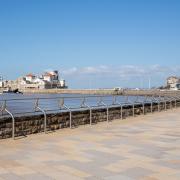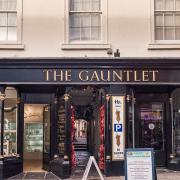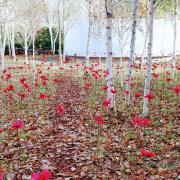Now, I like a good museum. Some people inexplicably prefer theme parks. It takes all sorts. At least a museum is a slice of real life, albeit our past life

The West Somerset Rural Life Museum is a small thatched museum in the village of Allerford, which is about five miles from Minehead, one mile from Porlock, and just off the A39. Its situation gives me another reason to visit. Allerford itself is a pretty place replete with packhorse bridge, which nestles beside a ford, shaded by a walnut tree and surrounded by venerable, variegated red stone and thatched cottages. Picture postcard you might say. It was mentioned in the Domesday Book too, that land survey undertaken by William the Conqueror no less.
Having drawn you in, the museum is housed in a building that dates back to 1821, so back in the reign of George IV. It was built as the village school, which taught its pupils for 160 years, until 1981. The building is rented from the National Trust today, having first been opened as a museum by a charitable trust in 1984. All staff members are volunteers, operating happily in an environment which is relaxed and friendly.
Inside the museum is a veritable cornucopia of Somerset life, with displays of artefacts covering everything from domesticity (for example, cooking and doing the laundry), recreation (smoking a clay pipe, tending the garden and mowing the lawn), to the lot and tools of the tradesman and the equipment once wielded on our farms, such as ploughs and seed drills.
There is also a West Somerset photographic archive, running to around 60 albums, and an outdoor display area. Demonstrations of local crafts are also held sometimes at the museum, plus topical memorabilia exhibitions.

The collection was originally started due to the efforts of the West Somerset Archaeological Society and has grown to an inventory of several thousand items covering a period from the early 1800s to the late-1950s. Whilst there may be a step back in time, it often feels like a step into the recent past: there is ‘stuff’ here that I definitely remember from my grandparents’ home (who were blessed with an outside privy incidentally).
Of course it would be remiss not to celebrate the building’s past as a place of learning and one room in the thatched building is dedicated to its past life as a school. The Victorian classroom is a setting where children can dress in original clothing, sit at the original desks and benches and write on slates. That reminds me of that old joke about my own schooldays being so long ago that I did indeed write on slates. The only problem was the tendency to slide off the roof in wet weather. I am tempted to say that this might be the place for a bit of good old-fashioned 3Rs: rote-learning and the chance to learn those useful times-tables that even seem to have passed the odd Schools Minister by. There are toys (some of which can be played with), text books, samplers and examples of school work that transport us back to the Victorian era. Children also seem to enjoy hearing about the punishments of yesteryear, including the dunce’s cap and the cane.
Exhibits are displayed in four areas of the old school premises (main hall, the school room itself, the archive room, together with the outside displays). The main hall would have been the principle classroom of the old school and would have been home to up to three separate classes, all being schooled simultaneously. The school room was the infant classroom and still contains the original long desks and benches so redolent of the early-1800s. The outbuildings contain tools and artefacts, with many trades represented, including a shoemaker’s shop, dairy and blacksmith, plus forestry, cider-making, thatching, carpentry and so forth.
Pauline Hall, who is officially the museum’s treasurer and unofficially a general ‘doer’, told me of her love for the place: “I first volunteered around eight years ago, when living locally, and began doing the banking and accounting to help out. All the people who work to keep the museum going are volunteers and I think we all share the same passion for a wonderful attraction that was set up with vision, energy and hard work after the school had closed. I believe we have a responsibility to keep it going in their honour. You could call it a ‘labour of love’.

“We all get a real buzz out of seeing visitors enjoying our offering. Schools from all over Somerset visit, play in the playground with Victorian toys, and experience two Victorian lessons, one in the schoolroom writing on slates and one in the main hall, where they learn how laundry was done before the washing machine.
“Quite often children enjoy their school visits so much they return with their parents, who see things exhibited they remember. We even get people visiting us who went to school here (including World War Two evacuees), who will then find themselves, or a relative, in the photographic archive. That’s so nice, to see the memories flooding back and we feel we provide a very real, important link to the past.
“One thing our collection conveys is just how hard life was in the past. We don’t always appreciate how lucky we are today. After contemplating a mangle, it’s nice to head out to the outdoor picnic area and the garden by the river, which is all very idyllic.
“Although I moved out to Minehead, I do enjoy coming back to the museum and village a couple of times a week, as I really appreciate the community spirit here. We have lots of pictures of the village in days gone by and it is nice to see that it has barely changed; a little bit of old England. We have the forge next door and the Post Office is still open in the village for 12 hours each week. As well as providing an essential lifeline for the community, they also have scrummy homemade cakes!
“We’re always in need of more volunteers though, so if there’s anyone who lives nearby who’d like to share this wonderful place with us, then please get in touch, even if you can only spare the odd hour.
“You’d be given a warm welcome. You could even pop to the Post Office for the cakes!”
Museum entry:
The museum is open from April until the end of October, 10.30am-4pm Tues-Fri, 1.30-4pm weekends & bank holidays.
Admission: Adults £2, children 50p. Schools and larger parties by prior arrangement.
For more information visit The West Somerset Rural Life Museum website.




